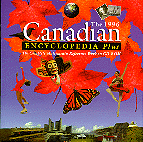
Volume II Number 2
October 27, 1995


|
The 1996 Canadian Encyclopedia Plus.
Toronto: McClelland & Stewart, 1995.
CD-ROM. Windows & Mac versions included. $99.95.
Subject Headings:
Electronic encyclopedias, Canadian.
English language-Canada-Dictionaries.
All ages.
Review by Duncan Thornton.
|
Windows version requires a multimedia PC, Windows 3.1 or later, 385SX
or higher processor, 4 MB RAM, 256-colour VGA or VGA+display, and at
least 5 MB of hard-disk space. For best performance a double-speed or
faster CD-ROM drive and a 16-bit sound card are recommended.
Macintosh Version requires a mulimedia Macintosh, System 7.0 or later, 68030 or higher processor, 5 MB of RAM and 6 MB of hard-disk space. For best performance a double spin or higher CD-ROM drive is recommended.
The Canadian Encyclopedia Plus bills itself as a complete
multimedia reference work on CD-ROM; it incorporates a somewhat improved
text of the Canadian Encyclopedia, as well as the
Gage Canadian Dictionary, the Columbia Encyclopedia
(Fifth Edition), and the Enhanced Roget's Electronic
Thesaurus. It also throws in "3,300 multimedia items."
And of course, for the many topics that have entries from both the
Columbia (symbolized by a little international globe in the
margin) and the Canadian (symbolized by a wee parochial
maple leaf) there's a difference in national outlook. For example, the
Canadian entry on the Vietnam war is harder on our government's
(relatively minor) involvement than the American entry is on theirs. And
the Columbia doesn't contribute any "multimedia" entries.

In fact, though there are many nice photos and illustrations, making
TCE+ fun to browse (I accidentally found, for example, two
good reproductions of work by Lionel Lemoine Fitzgerald, a painter
affiliated with the Group of Seven who lived just down the street from my house), the multimedia portion of the the CD-ROM as a whole is weak, heavily represented by bird calls and video clips of Canadian writers and politicians. And though the animated sequences range from the Battle of Quebec to Plate Tectonics, there are only twelve of them in the whole production. They cover their subjects well, considering they only have about a minute and a half to do it, but I found myself wistful for the
Grolier Multimedia Enclyopedia's surprisingly clear animated exposition of levers and mechanical advantage. ("Good Lord!" I
thought, "I may finally understand this!"), or even the overlapping
transparencies of the human body of the encyclopedias of my youth. There
is nothing so brutally useful or fascinating in these animated sequences, although at least the narrator's accent is Canadian.

The package also integrates the Gage Canadian
Dictionary, which will be even more familiar, and gets middling
marks as a working dictionary, and one that isn't particularly Canadian,
in that it prefers American spellings -- "color" to "colour," say --
even in its text, though naturally it does include Canadianisms like
tuque, or bluff (as in a stand of trees). Nor is the
Gage especially scholarly, though of course students
interested in etymology should just be marched straight over to the
Oxford English Dictionary anyway.
The enhanced Roget's Electronic Thesaurus is also
integrated into the dictionary, and it's, well, a dictionary-style
thesaurus. Good for finding a synonym when your mind has gone blank (and
with an integrated dictionary students won't end up saying the wrong
thing by using a word they don't know), but it's not a true thesaurus: it
doesn't organize words into categories. With a real thesaurus you can use
categorization to go from having an intuition that the word you want has
something vaguely to do with putting things together to finding (aha!)
adduce in fairly short order; this electronic version is just a
synonym hunter, although to be honest that's all most students want.
(Adduce doesn't appear in it at all, by the way.)
Finally, ready at almost anytime, is a Canadiana quiz. It's
challenging, and with every answered question you get a piece of a
Canadian picture (like Canada's coat of arms) that you then move around
to complete a puzzle. A pleasant diversion, and I got fourteen out of
twenty-two right without pressing the "clue" button.
That's a round-up of the content of TCE+, but of
course it's the software design that makes or breaks a multimedia
endeavour. In this case, the array of tools around the main screen takes
a while to figure out; at first you keep finding yourself in modules you
don't want to be in. Casual or occasional users will probably need help.
And the combination of the two encyclopedias is a little awkward.
TCE+ also includes a "Research" function that lets you
gather articles, etc., related to your topic of interest in a folder, and
highlight the relevant text, although again, it takes a while to get
comfortable using it. By comparison the Grolier multi
media encyclopedia has a less ambitious, but easier-to-learn interface.

TCE+ has two search modes: Search, which lets
you use Boolean operators, and SmartSearch, which lets you type in
what you want to know in plain English (the computer apparently then
hunts your text for key words and just does a standard Search). There are
also an option for narrowing your search results by weighting the search parameters, but it takes time to set up properly. It's faster just sorting through the hits a standard Search turns up yourself.
Still, the longer I've used it, the more fond I've become of
TCE+. It is fun just to browse through, and it does do the
work of three or four reference works in one. Once students get the hang
of it, they'll find it highly useful. With practice they'll start to
enjoy using it.

A larger question is whether CD-ROM is the right medium for this
information in the first place. It's not really faster to look things up
on a CD-ROM than it is in paper encyclopedias, dictionaries, etc. --
probably slower. And whereas several students can share volumes of a
bound encyclopedia, only one at a time can really use TCE+
-- and while they're using it, they're also monopolizing a computer. I'm
not sure whether the chance to actually see and hear Irving
Layton talk about poetry for thirty seconds or so makes up for some of
the practical difficulties. On the other hand, if you already have the
computer equipment, having all of these reference works gathered on one
CD is economical.
At my most cynical, I think the real purpose of an encyclopedia on
CD-ROM is to facilitate plagiarism (just cut and paste!) but that's
unfair to TCE+. For students who have to time to learn its
ins and outs, TCE+ will make studying things Canadian fun
enough to increase their interest in the subject.
Recommended with reservations.
Duncan Thornton is the editor of CM.


 Copyright © 1995 the Manitoba Library Association.
Reproduction for personal use is permitted only if this copyright notice is
maintained. Any other reproduction is prohibited without permission.
Copyright © 1995 the Manitoba Library Association.
Reproduction for personal use is permitted only if this copyright notice is
maintained. Any other reproduction is prohibited without permission.
Published by
The Manitoba Library Association
ISSN 1201-9364
 Go back to CM Welcome page
Go back to CM Welcome page
 Go back to Table of
Contents for this Issue
Go back to Table of
Contents for this Issue










 Copyright © 1995 the Manitoba Library Association.
Reproduction for personal use is permitted only if this copyright notice is
maintained. Any other reproduction is prohibited without permission.
Copyright © 1995 the Manitoba Library Association.
Reproduction for personal use is permitted only if this copyright notice is
maintained. Any other reproduction is prohibited without permission. Go back to CM Welcome page
Go back to CM Welcome page
 Go back to Table of
Contents for this Issue
Go back to Table of
Contents for this Issue